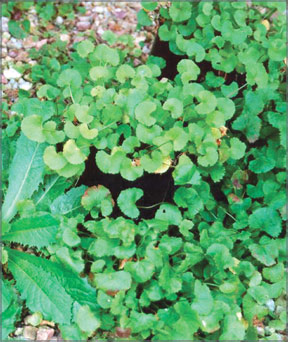Grow more iron rich plants and consume it
by Rosanne Koelmeyer Anderson
The high prevalence of iron deficiency in the developing world has
substantial health and economic costs, including poor pregnancy outcome,
impaired school performance and decreased productivity in general.
The World Health Organization estimates that a fifth of children
under five and a fifth of all women in developing countries are anemic
due to insufficient iron in their diets.
Iron deficiencies have not only caused problems to people in
developing nations but also to those in developed nations like the UK
where up to 21 per cent of girls and women are affected. It has been
observed that growing iron rich plants may be the best way of combating
iron deficiencies in people around the world as iron rich meat is too
costly for many people in the developing world.

Commenting on iron deficiency among people in Sri Lanka Consultant
Dietician /Nutritionalist ,Nawaloka Hospital ,Noor Z. Iqbal said that
our Sri Lankans don't eat "greens".
Parents have not trained their children to eat leafy green
vegetables. Educating the public that a sufficient intake of leafy green
vegetables in their daily diet is the only way of combating iron
deficiencies among all classes of people in society.
A programme to show the people how to plant leafy vegetables in their
own home based plots is best. People could be given the ingredients or
the little plants or plant seeds initially so that they can expand their
cultivation gradually and have a nursery. It is a spoon-feeding
exercise, she added.
All dark green leafy vegetables contain iron which can easily be
included in the daily diet of every child and adult and can be added
into their soups. However, the other substitute for iron deficiency is
liver, but it has to be taken with care as the intake of liver can give
rise to a increase in a person's cholesterol and sugar levels.
Anaemia is a medical condition that occurs when a person does not
have enough red blood cells. These cells contain hemoglobin, an
iron-rich protein that carries oxygen from the lungs to the body's
muscles and organs. The body requires oxygen for energy and therefore,
when you are anaemic, you may feel tired mentally and physically.
The reduced energy levels that result with anaemia lower a person's
ability to think, decreases productivity and increases the risk of
infection. For pregnant women there is a greater risk of dying in
pregnancy or childbirth. In children, anaemia can retard growth and
mental development.
In Sri Lanka, it is estimated that up to 40 per cent of children?
lack energy. When you are anaemic, you may feel tired mentally and
physically. Non-pregnant women have low hemoglobin (Hb) levels related
to iron deficiency.
Parasitic infections, particularly hookworm, have been identified as
a major contributing factor to anemia in women and children. Low dietary
availability of iron is also a major contributory factor. Sri Lanka's
favourite beverage is also a major culprit: tea being a strong inhibitor
of iron absorption.
As iron deficiency reduces physical work capacity, there are
significant economic implications for the country that are associated
with this condition.
What is anaemia? Blood is composed of three types of cells (red blood
cells, white blood cells, and platelets) that circulate throughout the
body. Red blood cells contain hemoglobin (Hb), a red, iron-rich protein
that carries oxygen to different parts of the body. Oxygen provides the
energy the body needs for all of its normal activities. When the number
of red blood cells decreases, the heart works harder to deliver.
Anaemia can be difficult to identify because early symptoms may be
mild. In addition, it is easy to mistake some symptoms of anaemia for
symptoms of other diseases or side effects of medication. As symptoms of
anaemia worsen, however, they can significantly affect a person's
quality of life.
Symptoms of anaemia include: 'Fatigue,' 'weakness,' Shortness of
breath and, dizziness or fainting. 'Pale skin, including decreased
pinkness of the lips, gums, lining of the eyelids, nail beds and palms
coupled with Rapid heart beat (tachycardia), Feeling cold, Sadness or
depression, Decreased sexual function, 'difficulty sleeping and'
Decreased appetite Possible causes of anaemia include may be attributed
to, Excessive blood loss, Diseases like Thalassaemia, Side effects of
medication Poor diet and vitamin or iron deficiencies Treatment Anaemia
can be a very serious condition and can affect the way you live.
Intake of iron rich vegetables
per 100 gms
100g. ml.
Gotukola
68.8
Nelli
33
Thampala (Amaranthus) 25.5
Passion Fruit leaf
25.5
Wattakka leaf
25.5
Mukunuwenna
16.7
Sweet potatoes leaves 16.3
Kohila leaves
16.3
Beetroot
16.2
Wing beans
10.7
Soya bean
10.5
Seasame seed
0.9
Green gram
8.5
If left untreated, anaemia can result in the need for blood
transfusions. The treatment for anaemia may vary depending on the
underlying cause. Your doctor will help determine the best treatment
options, such as diet modification, nutritional supplements, or
medication, if needed.
So growing more green leafy vegetables and makeing use of it in the
diet is fighting for a cause to combat iron deficiencies among Sri
Lankans.
[email protected]
|
